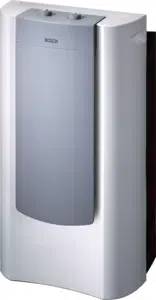Loading ...
Loading ...
Loading ...

In order to fit the expulsion tube assembly
properly in its housing, it is necessary to slide
the sleeve into the positioning slot (as shown
by the arrows on Fig. 12).
The diffusion duct, Fig. 10, is added when the
tube assembly has been fitted onto the
appliance.
Press the “Push” tab (Fig. 13, 1) and slide out
(Fig, 13, 2) to remove the assembly from the
appliance.
Temporary installation
❏ Open the window slightly and position the
diffusion duct between the jamb and the
glaze frame.
❏ Close the window as far as possible and
secure it with the suction pad supplied,
Fig. 14.
Fig. 12
Fig. 13
Fig. 14
26
Instructions for Use
During air conditioning, some of the
condensed water produced evaporates
automatically and is expelled outdoors
together with the expelled air through the hot
air expulsion tube.
In conditions of extreme humidity, the
appliance accumulates condensed water in an
internal tank. When a certain level is reached
an indicator light, Fig. 3, comes on indicating
that the condensed water tank is full and
needs to be emptied. When this happens, the
appliance stops cooling the air in the room
until the water is drained, as explained in
“Transportation requirements”, Fig. 7.
❏ It is recommended that you turn the
appliance off while draining the water.
Warning!
Remember that when the appliance is
turned off and turned back on, it is
necessary to wait for approximately 3
minutes before the compressor starts up
again. This period of time is required in
order to ensure correct appliance
operation.
Ways of releasing air outdoors
Fitting the air expulsion tube and
accessories onto the appliance
Fit the air expulsion tube assembly into the
housing on the top of the appliance at the
back, Fig. 11.
Housing for the
air expulsion
assembly
Fig. 10 Fig. 11
Loading ...
Loading ...
Loading ...
